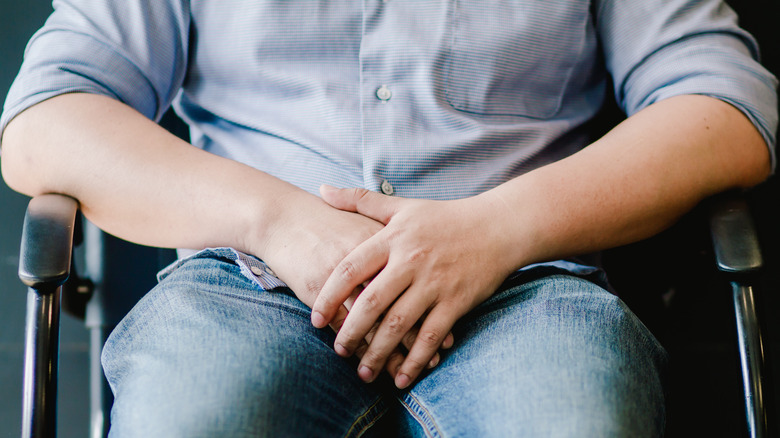Can Men Get Yeast Infections?
Yeast infections are an overgrowth of the common fungus Candida albicans. Most of the time, this fungus is present in small amounts on or in body parts that are moist, including the skin, the mouth, and, for women, the vagina. Normally the fungus remains in check, but at times it grows too much in one place, and a yeast infection results (per WebMD).
It's common knowledge women often have to deal with the itch and annoyance of yeast infections. But it's not so well-known that men sometimes have these infections too. An overgrowth of this fungus in men can lead to an infection on the penis or around the testicles. Symptoms of a male yeast infection include a red rash and shiny white patches on the penis, itching or burning in the area, a moist feeling or swelling on the tip of the penis, a thick white discharge under the foreskin, and trouble urinating or getting an erection. Because these symptoms can also indicate more serious problems, such as an STD, it's important to see a doctor as soon as they appear (via Healthline).
Causes of male yeast infections
One of the most common causes of a male yeast infection is having unprotected intercourse with a woman who has one herself, although the risk is considered low. About 15% of men will experience symptoms like an itchy rash on the penis, according to Well+Good, after such a sexual encounter.
Even without sexual activity, though, a man can develop a yeast infection, particularly if he's uncircumcised (candida likes to breed under the foreskin). Some other factors that contribute to yeast infections in men are practicing poor genital hygiene, undergoing a prolonged course of antibiotics, having diabetes, being overweight, or being immune-compromised in some way, according to Healthline. Sensitivity to perfumes in soaps and other chemicals can also increase a man's risk, according to WebMD, as can using spermicides or condoms that contain lubricants (per Verywell Health).
To prevent a yeast infection from developing or recurring, you should abstain from intercourse or use a condom if your partner has a yeast infection, clean and dry the penis well after showers and after having sex, use unscented soap and avoid skin products that cause irritation, and wear loose cotton underwear or boxers to keep the genitals cool and dry. Because they're at greater risk of getting a yeast infection, uncircumcised men are advised to diligently clean under the foreskin with soap and water, and to return the foreskin to its usual position after having sex.
Treatment and outcome
Typically, treatment consists of an over-the-counter topical antifungal ointment or cream, such as Lotrimin AF, Cruex, or Desenex (per Healthline). These creams are generally well-tolerated, and your symptoms should disappear within three to five days of starting treatment (via WebMD). The infection should clear up entirely within a week. If you are sexually active, your partner needs to be treated as well so reinfection doesn't occur. It's possible that partners can swap yeast infections back and forth if both of you are not treated and cured.
If your symptoms persist or they go away and then recur, secondary treatment may be necessary. Your doctor may prescribe both a prescription-strength steroid cream, as well as an oral medication called fluconazole. A yeast infection that doesn't respond to antifungal creams can lead to the potentially serious condition of balanitis, which is an inflammation of the foreskin or head of the penis. If not effectively treated, balanitis can cause adhesions on the penis, painful and difficult urination, swollen glands, and weakness and fatigue.
Persistent or recurring yeast infections may require two weeks of daily treatment followed by several months of weekly treatment. Uncircumcised men who don't respond to antifungal ointment or who have recurring symptoms of balanitis may be advised to have a circumcision.



